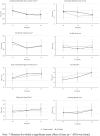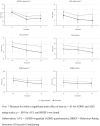Working memory training in children with borderline intellectual functioning and neuropsychiatric disorders: a triple-blind randomised controlled trial
- PMID: 34755919
- PMCID: PMC9298879
- DOI: 10.1111/jir.12895
Working memory training in children with borderline intellectual functioning and neuropsychiatric disorders: a triple-blind randomised controlled trial
Abstract
Background: Poor working memory, lower IQ and maladaptive behaviour form a triple disability known to have negative effects on the academic and social development of children with borderline intellectual functioning (BIF; IQ: 70 < IQ < 85) and neuropsychiatric disorders [attention-deficit hyperactivity disorder (ADHD) and/or autism spectrum disorder (ASD)]. Treatment possibilities for these children are scarce and hardly evidence based. This study primarily investigated whether adaptive computerised working memory training (WMT) may lead to significantly more improvement on a non-trained visuospatial WM task compared with a non-adaptive control WMT (placebo) in children with BIF and neuropsychiatric disorders. As secondary outcome measures, we used the scores on several non-trained neuropsychological near-transfer and far-transfer tasks as well as behavioural measures.
Method: We conducted a triple-blind placebo-controlled randomised clinical trial in 72 children (aged 10;0-13;11 years, 53 boys, 19 girls) with BIF and comorbid neuropsychiatric disorders (ADHD = 37, ASD = 21, both = 14) that were referred to child and adolescent psychiatry care, between May 2012 and March 2019. Children completed the Dutch version of Cogmed WMT, either the adaptive training version or the non-adaptive placebo version, 25 sessions (30-45 min a day), for 5 weeks. The primary outcome measure was the score on a non-trained visuospatial working memory task. The primary outcome was measured before and directly after 5 weeks of WMT and again 6 months after training.
Results: A total of 375 children were screened for eligibility and 72 were randomised. No significantly higher levels of improvement over time were found on our primary outcome measure in the experimental WMT group compared with the placebo control WMT, nor in the secondary (near-transfer and far-transfer tasks) or tertiary (behavioural measures) outcome measures. However, this study did show changes over time for these measurements for both the experimental and placebo conditions.
Conclusions: This study was unable to document superior training effects over time of an adaptive WMT in children with BIF and neuropsychiatric disorders, compared with a placebo (non-adaptive) WMT. The objectively documented changes over time in the non-adaptive WMT arm suggest that these children with persistent impairments in WM may benefit from a structured learning environment that is associated with improvement of neurocognitive functioning and coping strategies. Further research is needed to examine which elements of cognitive training may be useful for which specific patients and to study long-term effects of training.
Keywords: ADHD; ASD; borderline intellectual functioning; randomised controlled trial; working memory training.
© 2021 The Authors. Journal of Intellectual Disability Research published by MENCAP and International Association of the Scientific Study of Intellectual and Developmental Disibilities and John Wiley & Sons Ltd.
Conflict of interest statement
The authors report no conflicts of interest.
Figures





References
-
- Alloway T. P. (2007) Automated Working: Memory Assessment: Manual. Pearson.
-
- American Psychiatric Association (2000) Diagnostic and Statistical Manual of Mental Disorders, 4th edn Revised. American Psychiatric Association Press.
-
- Berger E. M., Fehr E., Hermes H., Schunk D. & Winkel K. (2020) The impact of working memory training on children's cognitive and noncognitive skills, vol. 9. NHH Dept. of Economics Discussion Paper.
-
- Brus B. T. & Voeten M. J. M. (1999) Eén‐minuut‐test: vorm A en B: verantwoording en handleiding: schoolvorderingentest voor de technische leesvaardigheid, bestemd voor groep 4 tot en met 8 van het basisonderwijs. Swets & Zeitlinger.
Publication types
MeSH terms
LinkOut - more resources
Full Text Sources
Medical
Research Materials

